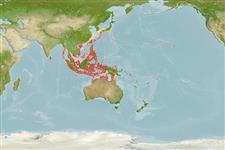>
Ovalentaria/misc (Various families in series Ovalentaria) >
Pomacentridae (Damselfishes) > Pomacentrinae
Etymology: Amphiprion: Greek, amphi = on both sides + Greek, prion, -onos = saw (Ref. 45335).
More on author: Cuvier.
Environment: milieu / climate zone / depth range / distribution range
Ekologi
laut berasosiasi dengan karang; nir-ruaya; kisaran kedalaman 1 - 15 m (Ref. 7247), usually 3 - 15 m (Ref. 55267). Tropical; 46°N - 17°S, 92°E - 147°E (Ref. 55267)
Indo-West Pacific: eastern Indian Ocean including Andaman and Nicobar Islands, Thailand, Malaysia, and northwest Australia to Singapore, Indonesia, and the Philippines; ranges north to Taiwan and the Ryukyu Islands.
Size / Weight / umur
Maturity: Lm ? range ? - ? cm
Max length : 11.0 cm TL jantan/; (Ref. 9710)
deskripsi pendek
Kunci identifiaksi (pengenalan) | Morfologi | Morfometrik
Duri punggung (Keseluruhan (total)) : 10 - 11; duri punggung lunak (Keseluruhan (total)) : 13 - 17; Duri dubur: 2; Sirip dubur lunak: 11 - 13.
Adults inhabit coral reefs where it lives among the venomous tentacles of large sea anemones (Ref. 85309). Occur in shallow and calm lagoons. Are protandrous hermaphrodites (Ref. 32167). Distinct pair is monogamous (Ref. 32167). Oviparous, distinct pairing during breeding (Ref. 205). Eggs are demersal and adhere to the substrate (Ref. 205). Males guard and aerate the eggs (Ref. 205). One of the most popular marine aquarium fishes. Bred artificially in Florida for the aquarium trade. Associated with the anemones: Heteractis magnifica, Stichodactyla gigantea, and Stichodactyla mertensii (Ref. 5911). Has been reared in captivity (Ref. 35410, 35413, 35415, 35418, 35420). Has reached an age of 12 years in captivity (Alexandre Fontayne, pers. comm., 2006).
Life cycle and mating behavior
Kematangan | Reproduksi, perkembang biakan | Pemijahan | telur-telur | Fecundity | Larva
Benthic spawner. Length at sex change = 4.4 cm TL (Ref. 55367). Oviparous, distinct pairing during breeding (Ref. 205). Eggs are demersal and adhere to the substrate (Ref. 205). Males guard and aerate the eggs (Ref. 205). Also Refs. 240, 7471, 118437.
Allen, G.R., 1991. Damselfishes of the world. Mergus Publishers, Melle, Germany. 271 p. (Ref. 7247)
Status IUCN Red List (Ref. 130435: Version 2024-2)
ancaman kepada manusia
Harmless
penggunaan manusia
Perikanan: tidak ada kepentingan; Akuarium: Komersial
Alat, peralatan
laporan khas
muat turun XML
Sumber internet
Estimates based on models
Preferred temperature (Ref.
123201): 26.2 - 29.3, mean 28.7 °C (based on 1746 cells).
Phylogenetic diversity index (Ref.
82804): PD
50 = 0.5000 [Uniqueness, from 0.5 = low to 2.0 = high].
Bayesian length-weight: a=0.01479 (0.00651 - 0.03363), b=3.00 (2.81 - 3.19), in cm total length, based on LWR estimates for this (Sub)family-body shape (Ref.
93245).
Trophic level (Ref.
69278): 3.1 ±0.36 se; based on food items.
Daya lenting (Ref.
120179): Tinggi, Waktu penggandaan populasi minimum kurang dari 15 bulan (tm<1; Fec=600).
Fishing Vulnerability (Ref.
59153): Low vulnerability (10 of 100).
Nutrients (Ref.
124155): Calcium = 115 [69, 209] mg/100g; Iron = 0.909 [0.558, 1.451] mg/100g; Protein = 18.6 [17.5, 19.6] %; Omega3 = 0.142 [0.086, 0.235] g/100g; Selenium = 18.8 [10.6, 37.0] μg/100g; VitaminA = 223 [75, 636] μg/100g; Zinc = 1.84 [1.26, 2.60] mg/100g (wet weight);
